The Apple WWDC 2015 Rundown
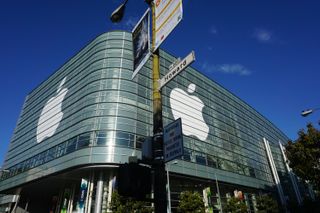
Apple announced iOS 9, Mac OS X El Capitan, WatchOS 2, Apple Music, and new developer tools today at its annual World Wide Developer Conference (WWDC) in San Francisco. Almost all of these were expected, and while there were plenty of new goodies in the operating system upgrades, Apple made the biggest deal about its new Music service, perhaps described best as a combination of iTunes and Spotify, with a few little human twists.
Apple drove the point home with appearances by Jimmy Iovine, an endorsement speech from Drake, and a live performance of a brand-new song from The Weekend. Interestingly, Apple also announced that Music, coming to iOS 8.4 later this month, would be available in Android in the Fall.
Two of the more intriguing, but less flashy aspects of what Apple announced today, at least from a consumer standpoint, were developer focused: the migration of Metal to OS X and making Swift open source.

While Apple Music took over, there were some solid useability enhancements announced for OS X and iOS, and many of those changes continue to bring the Apple desktop/laptop and mobile ecosystems closer together in functionality and features, much as we're seeing Microsoft doing with Windows 10 on the desktop and mobile.
Both Microsoft and Apple continue to work hard to create compelling user experiences across devices, extended now to the wrist and into the home and health, with a push to insist we completely buy into their ecosystems.
iOS 9
Let's start with mobile. Apple announced iOS 9, which includes some enhancements to Siri, to search, and to some of the underlying technologies that impact the mobile device, including battery life, performance, and enhanced security. On the software side, Apple Pay gets some changes, as does the Notes app and Maps, and there's a new application called News.
One popular and expected feature of iOS involves multitasking. Double tapping the home button brings in a task switcher, where you can get an app preview, all on one screen, and move through them. If you're in an app, you can do a single finger swipe, which Apple calls Slide Over, and a second window appears and is fully interactive. You can swipe down from the top and showcase and bring in other apps. You can tap on the divider between windows, and it creates a split view (50-50 screen sharing), with both windows being fully active. All other gestures still work.
Stay on the Cutting Edge
Join the experts who read Tom's Hardware for the inside track on enthusiast PC tech news — and have for over 25 years. We'll send breaking news and in-depth reviews of CPUs, GPUs, AI, maker hardware and more straight to your inbox.
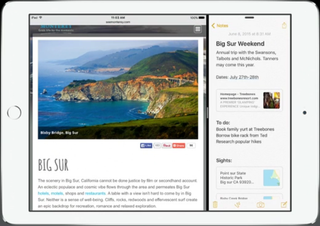
One demo brought up the Watch ESPN app, into a full video feed, and when launching email, that app resized and became picture in picture (PIP). The PIP could be moved and resized.
Apple said that it was providing the APIs to make all of this available to developers, and that the work to make use of it will be trivial for most developers.
The Slide Over feature and PIP work on iPad Air, Air 2, Mini 2, and Mini 3. The split view is only available on the iPad Air 2.
Siri, which Apple software VP Craig Federighi said, oddly, had "become quietly popular" with over one billion requests per week, had improved its word error rate down to 5 percent and was now 40 percent faster, though he didn't exactly say at what. Improvements include more specific requests, such as asking for photos by time and place; and more contextual awareness, like being able to ask Siri to remind you about "this," where Siri understands what "this" is (say, a web page, or an email).
Siri is also more aware of its surroundings and of your habits, and can become what Federighi said was a proactive assistant. Siri knows what you listen to when you run, or when you're in a car. Siri can automatically accept and schedule invitations, including reminders for those events, and she can take traffic into account. She can take a guess at who is calling you from an unknown number — although he didn't say how she was doing this, and clearly this isn't going to work for blocked numbers.
Search is also enhanced in iOS 9, making suggestions based on certain pieces of information it has, like who you might want to contact, or apps you tend to use at certain times of the day.

Swipe to left to get to search, and you'll get suggestions of people you might want to contact based on upcoming meetings; of apps you tend to use this time of day; and one tap access to places nearby. Apple said that search has more information, but much of this is coming from Microsoft Bing, which is the power behind Apple's search functionality. What Apple has added is an API for search, so app developers can expose app content to Apple search, and so that the content is deeply linked within the application.
All of this intelligence, Apple promised, does not invade our privacy. Apple doesn't mine photos, searches are anonymous and not associated with your Apple ID, meta data remains on the device, and identification is randomized and not shared with third parties.
Federighi glossed over many of the underlying changes to iOS 9. He mentioned extended battery life, improved performance and enhanced security. For security, he mentioned two factor authentication, but didn't provide much context beyond that. iOS 9 will have a settings feature that switches the device to low power mode, saving an additional three hours of battery life, Federighi said; this is a feature common on many Android phones today.
Other enhancements continue to come from reduced overhead in core animation and graphics thanks to Metal, Apple's lower-level API for iOS, announced during last year's WWDC.
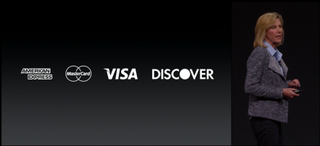
On the software side, Apple Pay is adding more bank and merchant support, and it will be a new feature of a new Square reader available this Fall. It will also be a part of a new feature coming from Pinterest, called Buyable Pins — which is really just as it sounds, assuming you know or care what Pinterest is, you social luddites! Apple Pay is also coming to the UK in July, with support from many banks and merchants, including the Underground (London subway).
Apple is also renaming its Passbook service, which stored reward and credit cards, along with other items such as airline or train tickets. It is now called Wallet, not to be confused with Google Wallet, which has now become, in part, Android Pay.
How did I get down that rabbit hole?
More iOS changes include an enhanced Notes app, including the ability to do more formatting such as creating checklists, creating finger sketches, and adding items from other apps. Maps now includes a public transit option, with specificity on station information, including exact entrance and exit locations. This will be available in more than 300 cities around the world, and Siri will also make use of it, as will Apple Pay (the location cards will tell you if the destination takes Apple Pay).

Finally, iOS 9 on the iPad has a few QuickType keyboard enhancements, including shortcuts for the suggestion bar, tools to cut/copy/paste, and various formatting options. Best of all, put two fingers on the keyboard and it becomes a trackpad. Thank goodness!
OS X El Capitan
With iOS 8, Apple introduced Continuity, which was a way of keeping experiences alive across Apple devices. In the newest version of OS X, called El Capitan, there are several features that bring the user experience between mobile and desktop/laptop together more tightly.
For example, in the Mail app, you can swipe your messages to keep or delete, as you would on an iOS device.
Apple is also bringing Metal to OS X. Metal brings developers closer to the hardware, specifically to the GPU, allowing developers to accelerate graphics and gaming, alleviating some of the overhead of OpenGL and OpenCL. Apple claimed that it can enhance rendering performance up to 50 percent and CPU performance by as much as 40 percent, all the while helping with battery life.
Adobe, Apple reported, has seen an 8x improvement in rendering effects in After Effects, and vast improvements (10x) in Illustrator's drawing engine.
Epic Games was on hand to showcase Fortnite, a doomsday multiplayer game running entirely on Metal, which is now baked into the Unreal Engine. The demonstration showed off the complex render effects, the detailed lighting, shadows, and shading. In one demonstration, the game was able to change its time of day view on the fly, with visible smoothness.

Apple said that this is also being adopted by The Foundry and Autodesk, so we'll see some of these improvements come to the professional side as well.
There was the usual bevy of user experience enhancements. There's a gigantic cursor upon waking up the Mac, the ability to Pin sites in Safari, and — Tom's Hardware readers afflicted with badly behaving audio ads might like this — the ability to mute a tab that suddenly begins playing out loud (and to quickly identify which tab it is).
The Spotlight Search feature is also enhanced to find what you need in more natural and contextual language. One example Federighi demonstrated was searching for "mail ignored from Phil [Schiller, Apple's marketing chief]." Or "documents I worked on last June."
Apple has attempted to make windows management easier, with a new mission control interface. You can work on two windows side-by-side in a split screen. You can click and hold the green expand button on a window and drag it, and snap it to another window. If you're working in Mail in full screen, you can click away on an email you're composing to see an incoming message, and you can open up tabs in the compose window. You can drag windows up to the spaces bar, and even drag a window into a desktop view with an app already buried in it, and create a split view.
This is the nitty gritty UI stuff that Apple gets obsessed with, and that its power users really love.
And, of course, it's all faster, Federighi said.
WatchOS
Let me preface this by saying I'm not yet a wearables convert. But Apple continues to move the Watch quickly into its ecosystem of devices, bringing its learnings from iOS into the fold. Apple CEO Tim Cook prefaced his Watch remarks by pointing out how the Apple app store began only seven years ago, but has surpassed 100 billion app downloads. "It has forever changed software distribution," he said, in one of those bits of hyperbole that, for me at least, actually rings true.
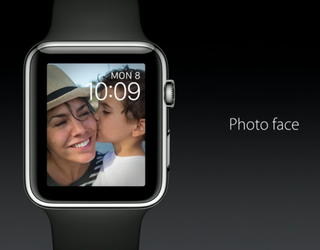
And so, Apple wants to wash/rinse/repeat for the Watch, and WatchOS 2 is a step in that direction because Apple's stated goal here is to bring native applications to the watch, rather than having them all tethered through an iPhone.
What follows is a mixture of items being exposed for developers and features Apple is adding in the new version of the OS. For example, Apple has made a big deal about Watch being a watch, with many clock face concepts, and now Watch users can make a clock face using a photo; use a photo album and it changes photos every time you raise your wrist. Apple has also created a 24-hour timelapse from around the world, and that timelapse will actually be time-relevant — that is, it will look like 7 pm somewhere when it's 7 pm.
In watch parlance, a complication is any detail beyond hours and minutes, and Apple is letting developers make their own complications. Apple showed some examples, like flight and gate information, home control system information, and scores from the MLB app.
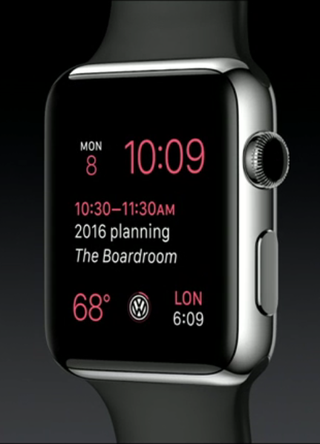
Apple has also added what it called Time Travel to the watch, which is the ability to rotate the crown to go forward in time to pull up information for the future, like weather, or your calendar appointments.
There were many more features, including the ability to reply to email, to conduct Facetime audio calls, and to bring native fitness apps into the overall Watch activity center. Apple Pay and Wallet will also be included, as will the new transit capability in Maps. You'll also be able to access HomeKit devices.
Developers will have access to the microphone, audio playback, video playback, HealthKit, HomeKit, the accelerometer, the taptic engine, and the use of the digital crown for input control.
Apple Music
Apple Music, powered by Apple's $3 billion acquisition of Beats last year, was the least surprising surprise of all, given leaks of the service by Sony's CEO the evening before.
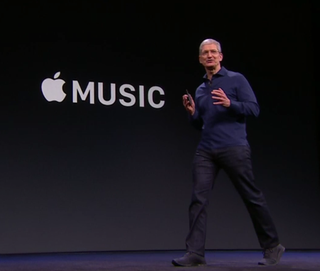
Ironically, I saw both Jimmy Iovine and Trent Reznor on a recent visit to Apple. Perhaps my sleuthing skills are eluding me these days. Iovine discussed the disruption that the music industry went through back in 2003, before iTunes, and compared today's landscape to that time, pointing to all of the streaming services, video services, and social media sites. "Let's build a better ecosystem," Iovine said he told Apple.
Thus, Apple Music, a combination of a music catalog for streaming music from iTunes, a 24-hour global radio station called Beats1, and Connect, which is a platform for promising and unknown artists to showcase their goods. Iovine said that the music service isn't based solely on algorithms, clearly a knock on Spotify and Pandora, but is curated by leading music experts whom Apple has hand picked.
The streaming service is a combination of the songs you've purchased and playlists you've made, with new music recommendations, personalization based on your tastes (partly your own input, and partly based on what it sees you listening to), and recommended and thematic playlists, much like other services.
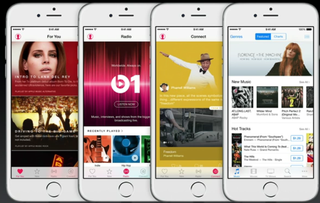
Iovene painted Beats1 as Trent Reznor's idea, and it is broadcast in New York, Los Angeles and London.
The price is consistent with competitive services (namely Spotify) at $9.99 per month. Apple offers a family plan, allowing up to six members at a total price of $14.99; for this, everyone gets their own account, library and recommendations, eliminating some of the confusion from doing this in iTunes. Apple is giving away the first three months for free. It will be in iOS 8.4 later this month, and on Android by the Fall.
Apple's Iovine and Eddie Cue sprang many accolades on us: "great music without restrictions," and "just music that is great and feels great," and "only one master, music itself." The Connect service, populated today with music and lyric notes from the likes of Chris Cornell, Bastille, and Alabama Shakes, will test the limits of a lofty-sounding ideal.
Apple's advantage is that its music applications and services are so widely used. We'll see if its subscription model can be just as dominant.
And All That Other Stuff
This is a developer conference, after all, and there were a number of announcements around new tools and kits. Most significantly, Apple announced Swift 2. Swift is the development kit for iOS, Mac OS and WatchOS. Swift 2 will offer many new features, including faster compiling, better error handling, and, in an announcement that seemed to stun the developers in the crowd, Apple is making it open source.
Apple didn't have as much to say about HomeKit and HealthKit, but HealthKit does get a few added metrics such as hydration, UV exposure, and data related to reproductive health.
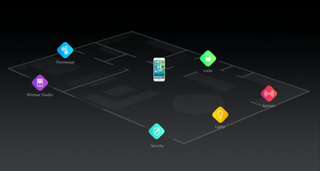
HomeKit includes enhancements for windows shades, motion sensors, third party security systems and carbon monoxide sensors. You can also access your HomeKit devices via iCloud.
We hope to hear more about HomeKit in the future.
Final Grades
That's quite a bit. No bright and shiny hardware, and a million tweaks under the hood. Two hours of everything but the kitchen sink. It's always easy to get caught up in the vortex of these events, no matter who is putting them on. Every executive presenting asks "Isn't this cool?" And promises "You're really going to love this."
Why shouldn't they? These are their projects, their life's work. All companies who put on conferences people the crowd with employees, who are prompted to applaud at each itty bitty reveal, and the keynote at WWDC 2015 was no exception.
I'll give Apple a "B" for volume announcements and an "A" for showmanship. As for substance, it's an incomplete until we can see some of this in action.
Follow Fritz Nelson @fnelson. Follow us @tomshardware, on Facebook and on Google+.
-
SirTrollsALot You know what apple should do... Is get its butt into making Apple Colleges worldwide that way they will have limitless imagination from budding applytes. But you know they wont do it, cause they are all about hoarding money and not giving it back.Reply -
fyend - Shit that's been on other platforms for years that we'll claim is new and exciting and that we invented. That about sums it all up, as usual.Reply -
fuzzion Apple can just keep buying. Therefore they will always never have any problem with innovation.Reply -
Blueberries When I can install OSX on my home PC that I didn't have to purchase from a retail manufacturer I'll be a very happy man, or rather I'd at least like to see more universal driver support if anything. The addition of Metal I find particularly interesting-- mostly that this article names Adobe and Autodesk products. I also like that Apple seems to be making some effort to accompany users with larger resolutions by adding GUI support.Reply -
everygamer So, iterative software updates on their 3 platforms and a music streaming service to catch up spotify/pandora.Reply
Bleh -
ammaross ReplyWhen I can install OSX on my home PC that I didn't have to purchase from a retail manufacturer I'll be a very happy man, or rather I'd at least like to see more universal driver support if anything. The addition of Metal I find particularly interesting-- mostly that this article names Adobe and Autodesk products. I also like that Apple seems to be making some effort to accompany users with larger resolutions by adding GUI support.
Apple is a hardware company. Why would they allow you to install their add-on software (OSX) on anything and bypass their hardware? -
TEAMSWITCHER Great to see them working on performance again - I liked Yosemite even though it's a bit of a laggard. I'm impatiently waiting for the redesigned 15" MacBook Pro with a 7th generation Intel Core Processor, DDR4 ram, Force Touch Track-pad, and USB-C with Thunderbolt 3. All of that tech is coming this fall, and you all know damn well that Apple will be the first put a solid product on the market.Reply
I'm betting heavily the next MacBook Pro will shed significant weight and thickness to create the most portable - quad-core - laptop the world has ever seen. And, to top it all off, there will be a Space Grey version to match my iPhone. It will be glorious. -
Blueberries ReplyWhen I can install OSX on my home PC that I didn't have to purchase from a retail manufacturer I'll be a very happy man, or rather I'd at least like to see more universal driver support if anything. The addition of Metal I find particularly interesting-- mostly that this article names Adobe and Autodesk products. I also like that Apple seems to be making some effort to accompany users with larger resolutions by adding GUI support.
Apple is a hardware company. Why would they allow you to install their add-on software (OSX) on anything and bypass their hardware?
Well Apple is more a mobile company in that respect. Their hardware doesn't power their PCs, their powerful OS and cumbersome form factor does. After all, they use the same parts I do, just a different PCB. Why should they? Because it would create a larger network for developers and simultaneously cripple their competition. The only reason GNU/*Nix is alive today is because of user-based input and development.
As an educated consumer I'm not going to rely on Apple to mass-produce my PC, repair it if it breaks, and sell the part to me. I can build my own AIO, I can build it with the same or better specifications for a lower price. The ONLY thing that appeals to me is OSX.
Most Popular



